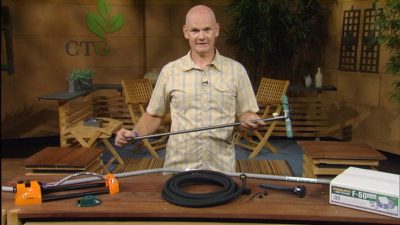Merredith Jiles’ Watering Techniques

While 2011 was a record year for drought in Texas, we live in a drought prone area. Appropriate watering techniques conserve resources and protect our garden investment.
Short term drought issues: Leaf drop, fruit drop, yellowing, insect attacks, increased wildlife foraging
Long term: Increased disease risks, root die-back, diminished winter hardiness, terminal die-back, death
Prioritize your landscape
High priority- Trees and shrubs
Medium- Perennials, fruits and veggies
Low- Annuals, ornamentals and potted plants, turf
Types of watering
Sprinklers: Best for large areas, but wasteful of water and regulated by watering restrictions. Have your system checked by a pro or by the city. For hose-end sprinklers, select one that disperses water closer to the ground.
The Hover sprinkler is a hand-held sprinkler that gently sprays water into a larger area than you can do with a typical hose-end attachment.
Drip: Less water is lost to evaporation since it delivers water directly to the plant roots.
Consider soaker hoses, drip irrigation systems, adapting sprinkler heads to drip, and watering bags like Treegator for trees.
Punch holes in 5-gallon buckets to place around trees and shrubs for slow watering that will sink in.
Injection: Water goes straight into soil. Best for large trees and shrubs. Allows for deep soaking, but takes time to do, since you do need to go around each side of the plant. One product is the Yard Butler tree watering tool.
How much to water?
You want the soil moist to about 6″ deep with trees and large shrubs. This may be just 1″ of water, but it depends on your soil. Use a small can to measure when you water. When the can has 1″ in it, check to see how deep the soil is moist. Continue watering (and time it!) to see how long it takes have moist soil 6″ below the surface.
New, small plants won’t need water to 6″ but the deeper the soil is moist, the more you encourage the roots to grow down. You want your perennials to develop deep roots. Annuals and vegetables stay closer to the surface, so 2 -3″ down is good for them.
Before you water again, check soil moisture with a trowel.
Water infrequently, but deeply. Once a week for smaller plants, especially new ones, and once a month for established plants. Once again, dig down to see how moist the soil is around the plants. Very small plants may need water more than once a week when you first plant them, depending on weather and your soil.
For more information, visit Austin’s Water Conservation site.
See this excellent video from The Texas Forest Service on techniques for watering and how to measure your soil moisture.
categories:
appeared on episodes:







